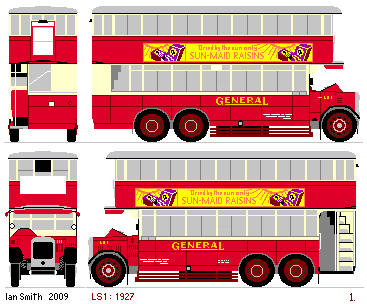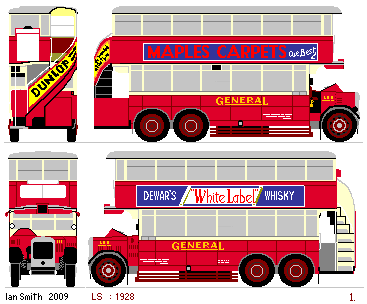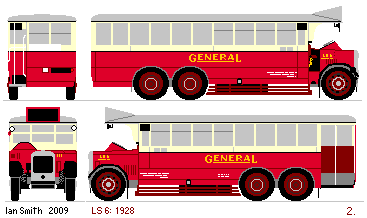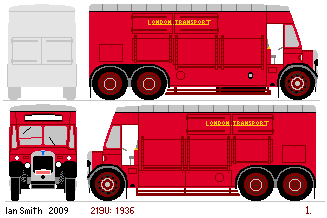
The London Sixes
This page created 13th October 2009|
Construction The small LS class of six-wheelers was something of an experiment.
Perhaps the best that can be said of them is that they paved the way for better things to come,
notably the Renown six-wheelers that closely followed them. Experimental they were:
building on the design of the successful NS class, they stretched the envelope, with a six-wheel chassis
allowing a 72-seater 29foot 8 1/4inch body with enclosed staircase to be fitted.
Well, seven did - four others had a 70-seater open-staircase body,
while one was a single-decker with 34-seater rear entrance body.
Two types of engine were fitted at first,
with either AEC's new 7.6 litre six-cylinder A121 or the Daimler 5.7 litre CV35.
The single-decker was built as a petrol-electric. They had pneumatic tyres.
They had a driver's cab door - but still no windscreen. Early ones had horizontally sliding opening windows,
later ones vertically sliding. Early ones had three windows across the flat part of the upper deck, later ones just two.
All this variety in a class of twelve.
Delivery was protracted, LS1 arriving in June 1927, and LS12 not appearing until January 1929.
The small LS class of six-wheelers was something of an experiment.
Perhaps the best that can be said of them is that they paved the way for better things to come,
notably the Renown six-wheelers that closely followed them. Experimental they were:
building on the design of the successful NS class, they stretched the envelope, with a six-wheel chassis
allowing a 72-seater 29foot 8 1/4inch body with enclosed staircase to be fitted.
Well, seven did - four others had a 70-seater open-staircase body,
while one was a single-decker with 34-seater rear entrance body.
Two types of engine were fitted at first,
with either AEC's new 7.6 litre six-cylinder A121 or the Daimler 5.7 litre CV35.
The single-decker was built as a petrol-electric. They had pneumatic tyres.
They had a driver's cab door - but still no windscreen. Early ones had horizontally sliding opening windows,
later ones vertically sliding. Early ones had three windows across the flat part of the upper deck, later ones just two.
All this variety in a class of twelve.
Delivery was protracted, LS1 arriving in June 1927, and LS12 not appearing until January 1929.
Into service Their service introduction was piece-meal too, perhaps to gauge reaction from a wide range of experiences.
LS1 and LS2 started at Cricklewood in summer 1927. LS3 arrived in February 1928 with the new engine, followed by the others.
The double-deckers went to Mortlake, five for the 33A; one went to Palmers Green for the 29A,
and two to Tottenham for the 69B. The single-decker went to Cricklewood for the 104 (where it stayed).
Their service introduction was piece-meal too, perhaps to gauge reaction from a wide range of experiences.
LS1 and LS2 started at Cricklewood in summer 1927. LS3 arrived in February 1928 with the new engine, followed by the others.
The double-deckers went to Mortlake, five for the 33A; one went to Palmers Green for the 29A,
and two to Tottenham for the 69B. The single-decker went to Cricklewood for the 104 (where it stayed).
The public liked the "London Sixes". So did the press. Not so the crews. There were squabbles about how to integrate duties for these massive buses amongst duties for much smaller ones, and over differential pay rates. These were exacerbated by the police requiring a list of drivers specially qualified to drive the big beasts. Other niggles were the mixture of open and enclosed staircases, and cab ventilation. These latter resulted in the conversion of all the enclosed staircase bodies to open, the general downseating to 66 seats, and the removal of cab doors. Consultations at very high level between the General management and the drivers' Trade Union resolved the pay issues. Continuing service By 1930 the modified double-deckers had been gathered to Tottenham for the 29 group.
They were further down-seated to 60.
In the autumn of 1930 they were transferred to Cricklewood for the 16.
That occasioned a further reduction in seating to 56 to meet a road bridge weight limit.
They were replaced between October 1936 and March 1937.
By 1930 the modified double-deckers had been gathered to Tottenham for the 29 group.
They were further down-seated to 60.
In the autumn of 1930 they were transferred to Cricklewood for the 16.
That occasioned a further reduction in seating to 56 to meet a road bridge weight limit.
They were replaced between October 1936 and March 1937.
LS3 stayed at Edgware. The 104 became the 240, but the bus stayed until withdrawn in 1936.
LS1 had a last fling in greener pastures, featuring as the Waiting Room at Sevenoaks Bus Station while a permanent structure was being built in 1937.
The Breakdown Tenders, 219U-222U Four of the retired London Sixes (LS3,6,8,10) were converted into Breakdown Tenders.
Four of the retired London Sixes (LS3,6,8,10) were converted into Breakdown Tenders.
LS6, the single-decker was first, in 1936.
Chiswick shortened the chassis and fitted a van body incorporating a full width cab,
equipment lockers and heavy duty winches, to produce 219U, the Hammersmith Breakdown Tender.
LS3, 8 and 10 followed in 1938, with bodies to the same design by Eagle of Warwickshire,
to be come 220U, 221U and 222U, for Dalston, Camberwell and Cricklewood.
They all survived the war, and lumbered out to breakdowns and overturned buses
until they were all withdrawn in April 1951.
Other 802sEight other ADC 802s were built. Two achieved notoriety as AEC staff transports, to take staff living near their old works in Walthamstow to the new AEC factory at Southall. These seated 104 and 102 passengers, with rearward facing seats at the front, flop-down gangway seats and even seats under the stairs!Five others were demonstrators, for Westciff-on-Sea, Maidstone & District, Southdown, Birmingham and Sheffield, whilst the remaining chassis never received a body. The Southdown open-top demonstrator was taken back by ADC and bought by the General for East Surrey. Seating sixty, it worked from Reigate on the 45 to South Merstham. Strangely, its body survived at least into the new Millenium. It was removed from the chassis in 1931, and moved to Herefordshire, where it sat on a K-type chassis! Owned by John Meaford in 2011, it has been deemed beyond preservation, and after removal of parts for other preservation projects will be (or has been) scrapped.
|
 Bus Stop
Bus Stop LS text.
LS text. LS histories
LS histories